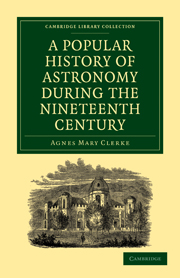Book contents
- Frontmatter
- PREFACE
- Contents
- INTRODUCTION
- Part I PROGRESS OF ASTRONOMY DURING THE FIRST HALF OF THE NINETEENTH CENTURY
- Part II RECENT PROGRESS OF ASTRONOMY
- CHAPTER I FOUNDATION OF ASTRONOMICAL PHYSICS
- CHAPTER II SOLAR OBSERVATIONS AND THEORIES
- CHAPTER III RECENT SOLAR ECLIPSES
- CHAPTER IV SPECTROSCOPIC WORK ON THE SUN
- CHAPTER V TEMPERATURE OF THE SUN
- CHAPTER VI THE SUN'S DISTANCE
- CHAPTER VII PLANETS AND SATELLITES
- CHAPTER VIII PLANETS AND SATELLITES (continued)
- CHAPTER IX THEORIES OF PLANETARY EVOLUTION
- CHAPTER X RECENT COMETS
- CHAPTER XI RECENT COMETS (continued)
- CHAPTER XII STARS AND NEBULÆ
- CHAPTER XIII METHODS OF RESEARCH
- INDEX
CHAPTER IV - SPECTROSCOPIC WORK ON THE SUN
Published online by Cambridge University Press: 07 September 2011
- Frontmatter
- PREFACE
- Contents
- INTRODUCTION
- Part I PROGRESS OF ASTRONOMY DURING THE FIRST HALF OF THE NINETEENTH CENTURY
- Part II RECENT PROGRESS OF ASTRONOMY
- CHAPTER I FOUNDATION OF ASTRONOMICAL PHYSICS
- CHAPTER II SOLAR OBSERVATIONS AND THEORIES
- CHAPTER III RECENT SOLAR ECLIPSES
- CHAPTER IV SPECTROSCOPIC WORK ON THE SUN
- CHAPTER V TEMPERATURE OF THE SUN
- CHAPTER VI THE SUN'S DISTANCE
- CHAPTER VII PLANETS AND SATELLITES
- CHAPTER VIII PLANETS AND SATELLITES (continued)
- CHAPTER IX THEORIES OF PLANETARY EVOLUTION
- CHAPTER X RECENT COMETS
- CHAPTER XI RECENT COMETS (continued)
- CHAPTER XII STARS AND NEBULÆ
- CHAPTER XIII METHODS OF RESEARCH
- INDEX
Summary
The new way struck out by Janssen and Lockyer was at once and eagerly followed. In every part of Europe, as well as in North America, observers devoted themselves to the daily study of the chromosphere and prominences. Foremost among these were Lockyer in England, Zöllner at Leipzig, Spörer at Anclam, Young at Hanover, New Hampshire, Secchi and Respighi at Rome. There were many others, but these names are conspicuous from the outset.
The first point to be cleared up was that of chemical composition. Leisurely measurements verified the presence above the sun's surface of hydrogen in prodigious masses, but showed that sodium had nothing to do with the orange-yellow ray identified with it in the haste of the eclipse. From its vicinity to the D pair (than which it is slightly more refrangible), the prominence-line was, however, designated D3, and the unknown substance emitting it was named by Frankland “helium.” Young is inclined to associate with it two other faint but persistent lines in the spectrum of the chromosphere; and Messrs. Liveing and Dewar pointed out, in 1879, that the wave-lengths of all three are bound together with that of the coronal ray “1474” by numerical ratios virtually the same with those underlying the vibrations of hydrogen, and also conformed to by certain lines of lithium and magnesium. This obscure but interesting subject deserves further inquiry.
- Type
- Chapter
- Information
- A Popular History of Astronomy During the Nineteenth Century , pp. 238 - 256Publisher: Cambridge University PressPrint publication year: 2010First published in: 1885



